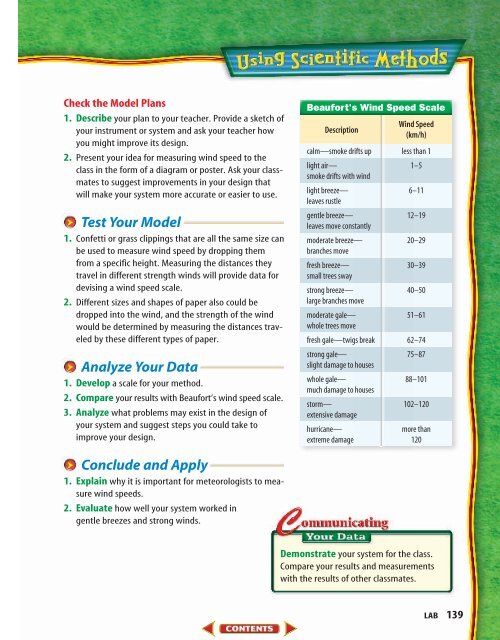Chapter 5: Weather
Chapter 5: Weather
Chapter 5: Weather
Create successful ePaper yourself
Turn your PDF publications into a flip-book with our unique Google optimized e-Paper software.
Check the Model Plans<br />
1. Describe your plan to your teacher. Provide a sketch of<br />
your instrument or system and ask your teacher how<br />
you might improve its design.<br />
2. Present your idea for measuring wind speed to the<br />
class in the form of a diagram or poster. Ask your classmates<br />
to suggest improvements in your design that<br />
will make your system more accurate or easier to use.<br />
Test Your Model<br />
1. Confetti or grass clippings that are all the same size can<br />
be used to measure wind speed by dropping them<br />
from a specific height. Measuring the distances they<br />
travel in different strength winds will provide data for<br />
devising a wind speed scale.<br />
2. Different sizes and shapes of paper also could be<br />
dropped into the wind, and the strength of the wind<br />
would be determined by measuring the distances traveled<br />
by these different types of paper.<br />
Analyze Your Data<br />
1. Develop a scale for your method.<br />
2. Compare your results with Beaufort’s wind speed scale.<br />
3. Analyze what problems may exist in the design of<br />
your system and suggest steps you could take to<br />
improve your design.<br />
Conclude and Apply<br />
1. Explain why it is important for meteorologists to measure<br />
wind speeds.<br />
2. Evaluate how well your system worked in<br />
gentle breezes and strong winds.<br />
Beaufort's Wind Speed Scale<br />
Description<br />
Wind Speed<br />
(km/h)<br />
calm—smoke drifts up less than 1<br />
light air— 1–5<br />
smoke drifts with wind<br />
light breeze— 6–11<br />
leaves rustle<br />
gentle breeze— 12–19<br />
leaves move constantly<br />
moderate breeze— 20–29<br />
branches move<br />
fresh breeze— 30–39<br />
small trees sway<br />
strong breeze— 40–50<br />
large branches move<br />
moderate gale— 51–61<br />
whole trees move<br />
fresh gale—twigs break 62–74<br />
strong gale— 75–87<br />
slight damage to houses<br />
whole gale— 88–101<br />
much damage to houses<br />
storm— 102–120<br />
extensive damage<br />
hurricane— more than<br />
extreme damage 120<br />
Demonstrate your system for the class.<br />
Compare your results and measurements<br />
with the results of other classmates.<br />
LAB 139

















